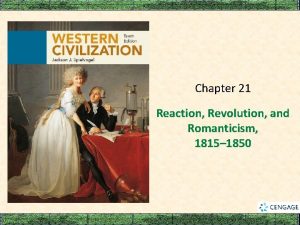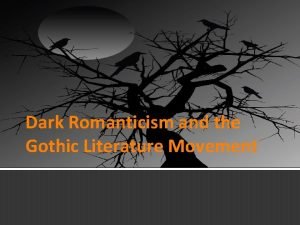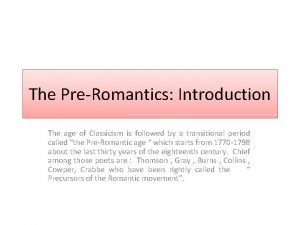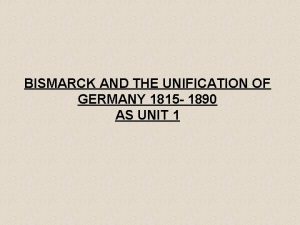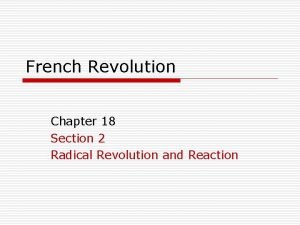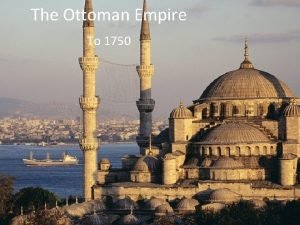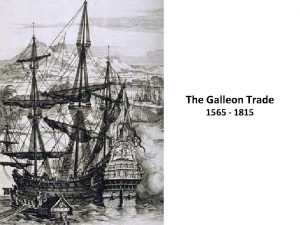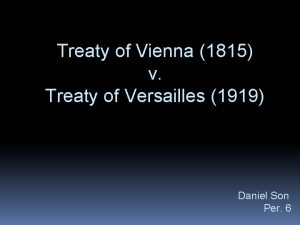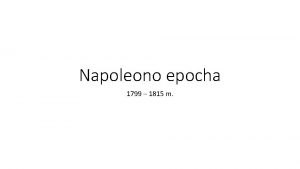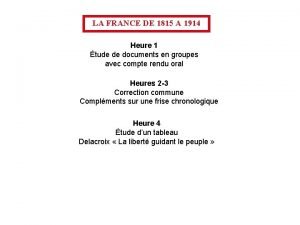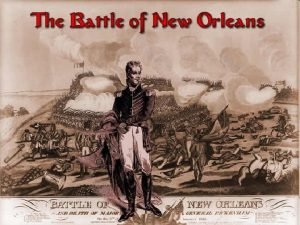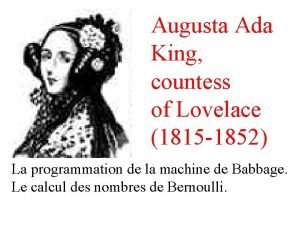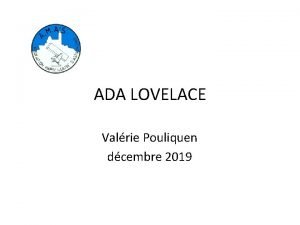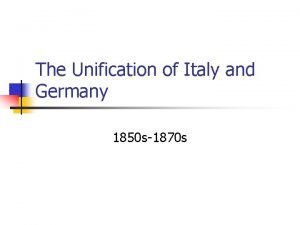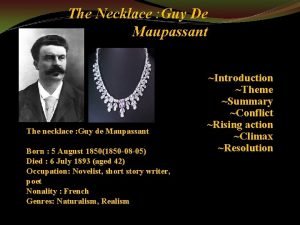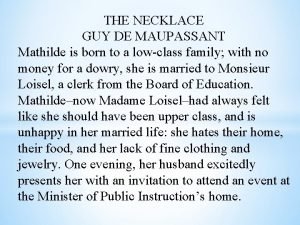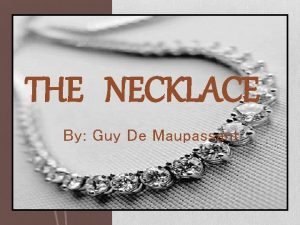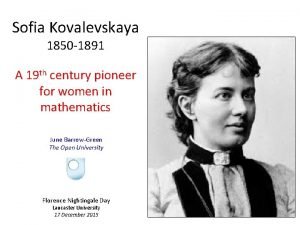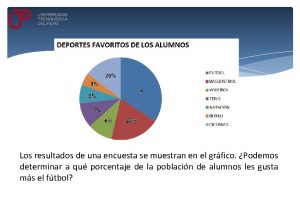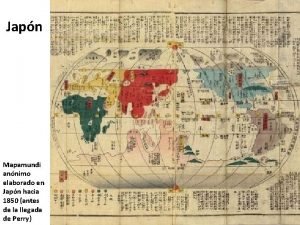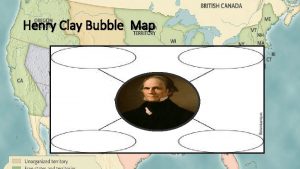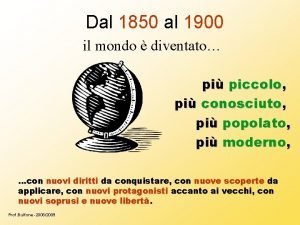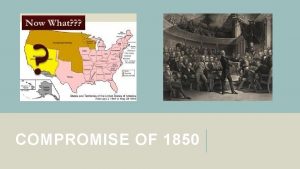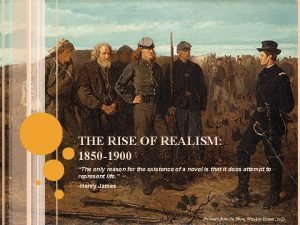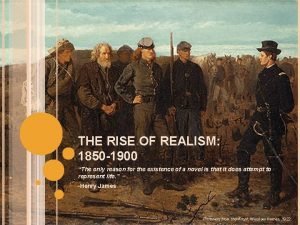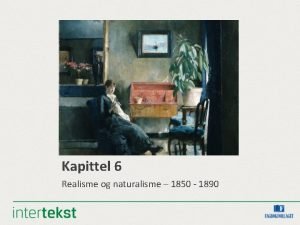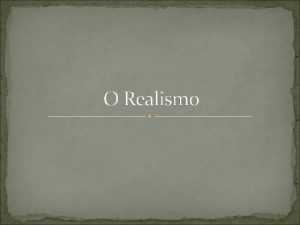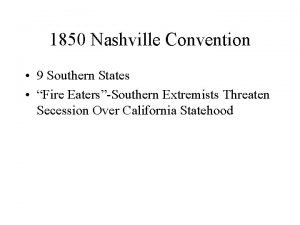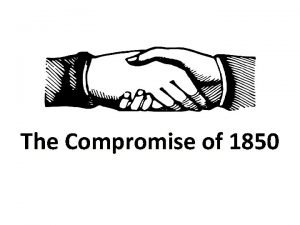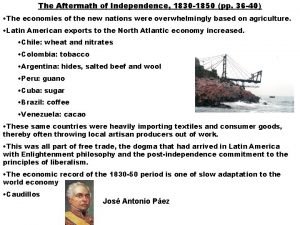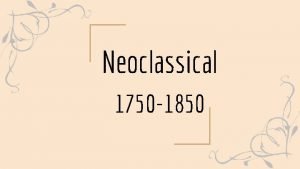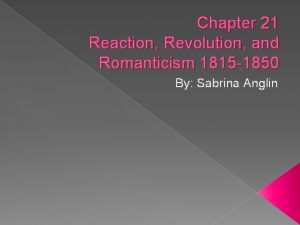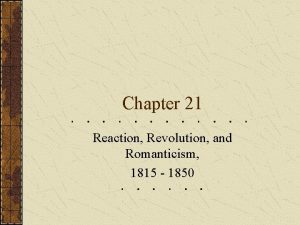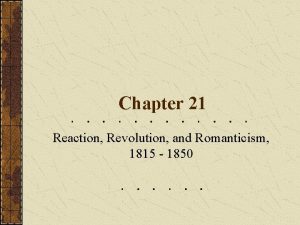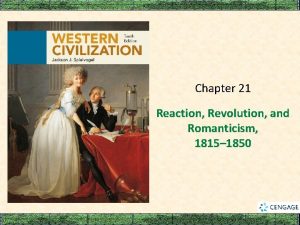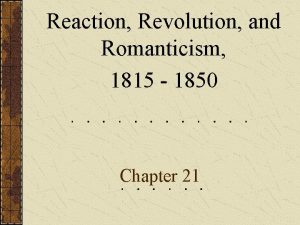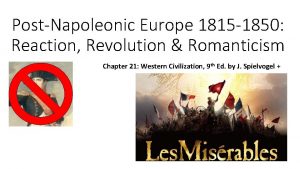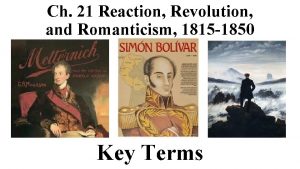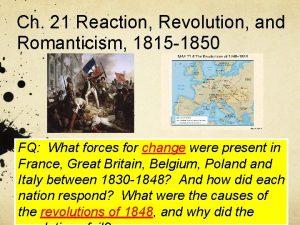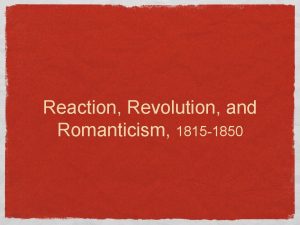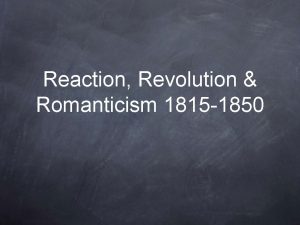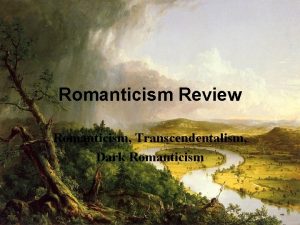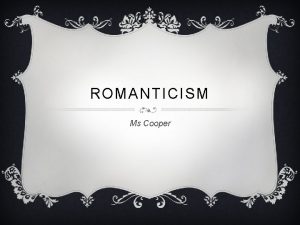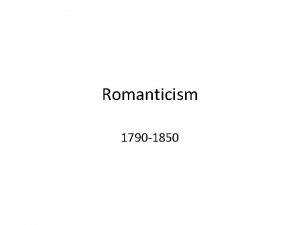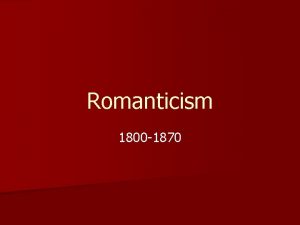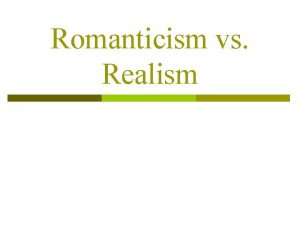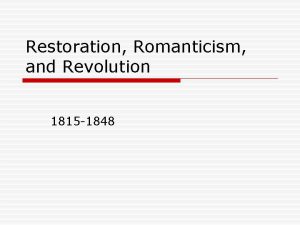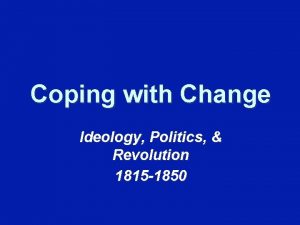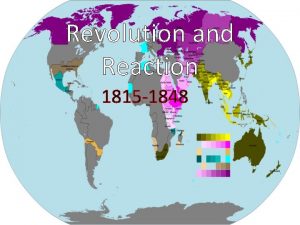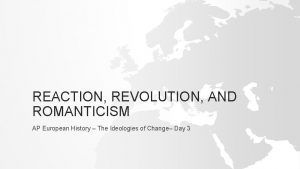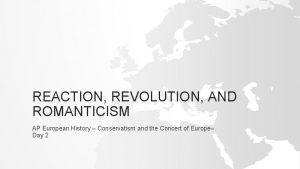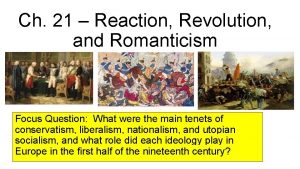Chapter 21 Reaction Revolution and Romanticism 1815 1850














































- Slides: 46

Chapter 21 Reaction, Revolution, and Romanticism, 1815– 1850

Focus Questions § § § What were the goals of the Congress of Vienna and the Concert of Europe, and how successful were they in achieving those goals? What were the main tenets of conservatism, liberalism, nationalism, and utopian socialism, and what role did each ideology play in Europe in the first half of the nineteenth century? What forces for change were present in France, Great Britain, Belgium, Poland, and Italy between 1830 and 1848, and how did each nation respond? What were the causes of the revolutions of 1848, and why did the revolutions fail? How did European states respond to the increase in crime in the late eighteenth and early nineteenth centuries? What were the characteristics of Romanticism, and how were they reflected in literature, art, and music?

A gathering of statesmen at the Congress of Vienna p 620

The Conservative Order § The Peace Settlement § Congress of Vienna § § The principle of legitimacy § § Variations in the restoration of traditional powers A new balance of power § § Prince Klemens von Metternich (1773 – 1859) Defensive barriers against France The Ideology of Conservatism § Influences: Edmund Burke, Reflections on the Revolution of France (1790) § § Obedience to political and religious authorities Rejection of revolution and liberal demands

MAP 21. 1 Europe After the Congress of Vienna, 1815 Map 21. 1 p 622

Conservative Domination: the Concert of Europe § § § More Congresses: the Quadruple Alliance The Principle of Intervention Allied intervention against revolution Breakdown of the Concert of Europe The Revolt of Latin American independence § § Simón Bolívar (1783 – 1830) and José de San Martín (1778 – 1850) Maintaining European economic dependence § The Greek Revolt (1821 -1830) § Lesson: intervention could also support revolution as well

The Liberators of South America José de San Martín of Argentina and Simón Bolívar are hailed as the leaders of the Latin American independence movement. p 624

MAP 21. 2 Latin America in the First Half of the Nineteenth Century Map 21. 2 p 626

CHRONOLOGY Conservative Domination: The Concert of Europe Event Congress of Vienna Congress of Aix-la-Chapelle Revolutions win independence for Latin America Dates 1814– 1815 1818 1819– 1824 Congress of Troppau Congress of Laibach Crushing of revolt in southern Italy Greek revolt against the Ottoman Empire Congress of Verona Crushing of revolt in Spain Monroe Doctrine Treaty of Adrianople Independence of Greece 1820 1821 1822 1823 1829 1830 p 627

The Balkans by 1830 p 627

Conservative Domination: The European States (Slide 1 of 2) § Great Britain: Rule of the Tories § Landowning classes dominate Parliament § § Restoration in France § § § Tory and Whig factions, with Tories in the ascendancy The return of the Bourbons Unresolved tensions: grudging moderation, ultraroyalist opposition Intervention in the Italian States and Spain § Reactionary governments in Italy § § Nationalistic aspirations (the Carbonari) Bourbons restorations in Spain

Peterloo Massacre This colored etching depicts the massacre on August 16, 1819, in St. Peter’s Field in Manchester. p 627

Italy, 1815 p 628

Conservative Domination: The European States (Slide 2 of 2) § Repression in Central Europe § The German Confederation § § Prussian leadership: reforms but little interest in unity Forces of nationalism and the Burschenschaften The multinational Austrian Empire Russia: Autocracy of the Tsars § § Alexander I (1801 – 1825): from reform to reaction Nicholas I (1825 – 1855) § Impact of the revolt of the Northern Union

Ideologies of Change (Slide 1 of 2) § Liberalism § Economic liberalism (Classical Economics) § The concept of laissez-faire § § § Political liberalism § § Common belief: guarantee of civil liberties for all John Stuart Mill (1806 – 1873), On Liberty § § Thomas Malthus (1766 – 1834) and the case against government intervention David Ricardo (1772 – 1823): “iron law of wages” Women’s rights: On the Subjection of Women Nationalism § The idea of the nation as a force for change § Features: common institutions, traditions, language, and customs; alliance with liberalism

Ideologies of Change (Slide 2 of 2) § Early Socialism § § § Focus on social equality, human cooperation, and utopian aspirations Charles Fourier (1772 – 1838) Robert Owen (1771 – 1858) § § Louis Blanc (1813 – 1882) § § § Success and failure: New Lanark, Scotland, and New Harmony, Indiana Denunciation of competition, promotion of workshops Female supporters Flora Tristan (1803 – 1844)

MAP 21. 3 The Distribution of Languages in Nineteenth. Century Europe Map 21. 3 p 633

Children at New Lanark Robert Owen created an early experiment in utopian socialism by establishing a model industrial community at New Lanark, Scotland. p 634

Revolution and Reform (1830 -1850) (Slide 1 of 2) § Another French Revolution § Charles X (1824 – 1830): the July Ordinances § § Louis-Philippe (1830 – 1848), “bourgeois monarch” § § § Revolt by liberals Constitutional changes favor the upper bourgeoisie The Party of Movement (Adolphe Thiers) Party of Resistance (François Guizot) Rise of industrial working class Revolutionary Outbursts in Belgium, Poland, and Italy § Success for the Belgians; repression in Poland Italy

The Revolution of 1830 In 1830, the forces of change began to undo the conservative domination of Europe. p 635

Revolution and Reform (1830 -1850) (Slide 2 of 2) § Reform in Great Britain § The Whigs Come to Power, 1830 § § Concessions considered superior to revolution The Reform Act of 1832 § Recognition of industrial change § § § Eliminating rotten boroughs, enfranchising new towns and cities plus reapportionment Gave franchise to the upper middle class New reform legislation § § Laws halting industrial abuses Economic liberalism put into law § § The Poor Law of 1834 The repeal of the Corn Laws

The Revolutions of 1848 (Slide 1 of 3) § Yet Another French Revolution § § § Causes: depression, unemployment, scandals, corruption, and failure to initiate reform Abdication of Louis-Philippe: February 24 Provisional government established § § § Elections to be by universal manhood suffrage National workshops Growing split between moderate and liberal republicans June Days: Thousands killed Second Republic established § Charles Louis Napoleon Bonaparte, elected December

MAP 21. 4 The Revolutions of 1848– 1849 Map 21. 4 p 638

Political Cartoons: Attacks on the King (Slide 1 of 2) Caricatures of Louis-Philippe often portrayed him with a pear-shaped head, both because there was a resemblance and because the French word for pear—poire (PWAHr)—had the slang meaning of simpleton or fool. p 639

Political Cartoons: Attacks on the King (Slide 2 of 2) Louis-Philippe is shown with a pear-shaped head, running away from an angry crowd while carrying a bag of money. p 639

The Revolutions of 1848 (Slide 2 of 3) § Revolution in the German States § § French revolts led to promises of reform Frederick William IV (1840 – 1861) § § Frankfurt Assembly: failed liberalism Upheavals in the Austrian Empire § Louis Kossuth and Hungarian liberalism § § Subsequent urban demonstrations in Austrian lands lead to Metternich’s dismissal Restoring firm control § § Francis Joseph I (1848 – 1916) Imperial restoration and failed revolutions

The Revolutions of 1848 (Slide 3 of 3) § Revolts in the Italian States § Risorgimento and Giuseppe Mazzini (1805 – 1872) § Young Italy, 1831 § § § Cristina Belgioioso (1808 – 1871) Rebellions began in Sicily § § § Goal: a united Italy Rulers promised reforms The success of counterrevolutionary forces The Failures of 1848 § Political and nationalist divisions doom the cause of revolution

The Maturing of the United States § Liberalism and Nationalism in the U. S. § § American Constitution defended both major forces Divisions over the power of the federal government § § Effects of the War of 1812 Growth of the Supreme Court § § Alexander Hamilton (1757 – 1804), Federalist Thomas Jefferson (1743 – 1826), Republican John Marshall (1755 – 1835) Andrew Jackson (1767 – 1845) and mass democracy

CHRONOLOGY Reform, Reaction, and Revolution: The European States, 1815– 1850: Great Britain Event Dates Peterloo Massacre 1819 Reform Act 1832 Poor Law 1834 Repeal of Corn Laws 1846 p 642

CHRONOLOGY Reform, Reaction, and Revolution: The European States, 1815– 1850: France Event/Leader Dates Louis XVIII 1814– 1824 Charles X 1824– 1830 July Revolution 1830 Louis-Philippe 1830– 1848 Abdication of Louis-Philippe; formation of provisional government June Days: workers’ revolt in Paris 1848 (February 22– 24) Establishment of Second Republic 1848 (November) Election of Louis Napoleon as French president 1848 (December) 1848 (June)

CHRONOLOGY Reform, Reaction, and Revolution: The European States, 1815– 1850: Low Countries Event Dates Union of Netherlands and Belgium Belgian independence 1815 1830

CHRONOLOGY Reform, Reaction, and Revolution: The European States, 1815– 1850: German States Event Dates Frederick William III of Prussia 1797– 1840 Germanic Confederation established 1815 Karlsbad Decrees 1819 Frederick William IV of Prussia 1840– 1861 Revolution in Germany 1848 Frankfurt Assembly 1848– 1849

CHRONOLOGY Reform, Reaction, and Revolution: The European States, 1815– 1850: Austrian Empire Event Dates Emperor Ferdinand I 1835– 1848 Revolt in Austrian Empire; Metternich 1848 (March) dismissed Austrian forces under General 1848 (June) Windischgrätz crush Czech rebels Viennese rebels crushed 1848 (October) Francis Joseph I 1848– 1916 Defeat of Hungarians with help of Russian troops 1849

CHRONOLOGY Reform, Reaction, and Revolution: The European States, 1815– 1850: Italian States Event Dates Revolts in southern Italy and Sardinia 1821 crushed King Charles Albert of Piedmont 1831– 1849 Revolutions in Italy 1848 Charles Albert attacks Austrians 1848 Austrians reestablish control in Lombardy and Venetia 1849

CHRONOLOGY Reform, Reaction, and Revolution: The European States, 1815– 1850: Russia Event Dates Tsar Alexander I 1801– 1825 Decembrist Revolt 1825 Tsar Nicholas I 1825– 1855 Polish uprising 1830 Suppression of Polish revolt 1831

The Emergence of an Ordered Society § New Police Forces § French police § § British bobbies § § The military nature of the Schutzmannschaft Other approaches to the crime problem § § Growing professionalism Spread of police systems § § The duties of the Parisian serjents Reforms concerning poverty and morality Prison Reform § New emphasis on rehabilitation

The London Police One response to the revolutionary upheavals of the late eighteenth and early nineteenth centuries was the development of civilian police forces that would be responsible for protecting property, arresting criminals, and maintaining domestic order. p 643

Culture in an Age of Reaction and Revolution: The Mood of Romanticism § The Characteristics of Romanticism § Emphases: emotion, sentiment, inner feelings § § § Johann Wolfgang von Goethe (1749 – 1832), The Sorrows of the Young Werther Individualism Interest in the past § Fairy tales § § § The Grimm Brothers and Hans Christian Andersen Walter Scott (1771 – 1832) Gothic literature § § Edgar Allan Poe (1808 – 1849) Mary Wallstonecraft Shelley (1797 – 1851)

Neo-Gothic Revival: British Houses of Parliament The Romantic movement of the first half of the nineteenth century led, among other things, to a revival of medieval Gothic architecture that left European cities bedecked with neo-Gothic buildings. p 646

The Mood of Romanticism (Slide 1 of 2) § Romantic Poets § Poetry as an Expression of the Soul § Percy Bysshe Shelley (1792 – 1822) § § Lord Byron (1788 – 1824) § § Childe Harold’s Pilgrimage Love of Nature § William Wordsworth (1770 – 1850) § § § Prometheus Unbound The mysterious force of nature Pantheism Critique of Science

The Mood of Romanticism (Slide 2 of 2) § Romanticism in Art § § Romanticism in Music § § § Casper David Friedrich (1774 – 1840) Joseph Malford William Turner (1775 – 1851) Eugène Delacroix (1798 – 1863) Ludwig van Beethoven (1770 – 1827) Frenchman Hector Berlioz (1803 – 1869) The Revival of Religion in the Age of Romanticism § § Catholicism Protestantism

Caspar David Friedrich, The Wanderer Above the Sea of Fog The German artist Caspar David Friedrich sought to express in painting his own mystical view of nature. ‘‘The divine is everywhere, ’’ he once wrote, ‘‘even in a grain of sand. ’’ In this painting, a solitary wanderer is shown from the back gazing at mountains covered in fog. p 647

J. M. W. Turner, Rain, Steam, and Speed—The Great Western Railway Although Turner began his artistic career by painting accurate representations of the natural world, he increasingly sought to create an atmosphere through the skillful use of light and color. p 647

Eugene Delacroix, The Death of Sardanapalus Delacroix’s Death of Sardanapalus was based on Lord Byron’s verse account of the dramatic last moments of the decadent Assyrian king. p 648

Chapter Timeline p 650

Discussion Questions § § § How did the revolts in Latin America affect the trading patterns with Europe? How was the Greek revolt against the Ottoman Empire transformed into a noble cause? How did Russia’s actions affect the cause of Greek independence? How did John Marshall increase the power of the United States Supreme Court? How did the Romantics view society and the social conventions of the day?
 Chapter 21 reaction revolution and romanticism
Chapter 21 reaction revolution and romanticism Dark romanticism american gothic unit test
Dark romanticism american gothic unit test Thomas gray as a romantic poet
Thomas gray as a romantic poet The romanticism (1795 — 1835) what is romanticism
The romanticism (1795 — 1835) what is romanticism Liberalism and nationalism in germany 1815-71
Liberalism and nationalism in germany 1815-71 Radical revolution and reaction 18-2
Radical revolution and reaction 18-2 Ictahedron
Ictahedron Proton capture equation
Proton capture equation Ottoman empire 1750
Ottoman empire 1750 Sampan trade
Sampan trade Congresul de la viena si sfanta alianta
Congresul de la viena si sfanta alianta Congress of vienna vs treaty of versailles
Congress of vienna vs treaty of versailles Napoleono epocha
Napoleono epocha Frise chronologique 1815 à 1870
Frise chronologique 1815 à 1870 Frise chronologique france de 1815 à 1914
Frise chronologique france de 1815 à 1914 We fired our guns and the british kept a comin
We fired our guns and the british kept a comin 1815
1815 Augusta ada king, countess of lovelace
Augusta ada king, countess of lovelace Ada lovelace family background
Ada lovelace family background Sdružení pro vydávání a šíření českých knih
Sdružení pro vydávání a šíření českých knih Russian revolution vs french revolution
Russian revolution vs french revolution You should hope that this game will be over soon
You should hope that this game will be over soon Definition of third agricultural revolution
Definition of third agricultural revolution Unit of rate of reaction for first order reaction
Unit of rate of reaction for first order reaction Leukoerythroblastic reaction vs leukemoid reaction
Leukoerythroblastic reaction vs leukemoid reaction Where was prussia in 1850
Where was prussia in 1850 The necklace by guy de maupassant rising action
The necklace by guy de maupassant rising action Mathilde was born into the family of
Mathilde was born into the family of The necklace complication
The necklace complication Adrien marie legendre
Adrien marie legendre N
N Neoclassicism (1750–1850)
Neoclassicism (1750–1850) Dos depositos contienen 2587 y 1850
Dos depositos contienen 2587 y 1850 Japon mapamundi
Japon mapamundi Explain the compromise of 1850
Explain the compromise of 1850 Scoperte scientifiche dal 1850 al 1900
Scoperte scientifiche dal 1850 al 1900 Who created the compromise of 1850? *
Who created the compromise of 1850? * Types of collisions
Types of collisions Realism 1850 to 1900
Realism 1850 to 1900 Realism 1850 to 1900
Realism 1850 to 1900 Naturalisme
Naturalisme Entre 1850 e 1900 surge nas artes europeias
Entre 1850 e 1900 surge nas artes europeias Nashville convention 1850
Nashville convention 1850 Compromise of 1850
Compromise of 1850 1850*36
1850*36 Compromise of 1850
Compromise of 1850 Neoclassical (1750–1850)
Neoclassical (1750–1850)
